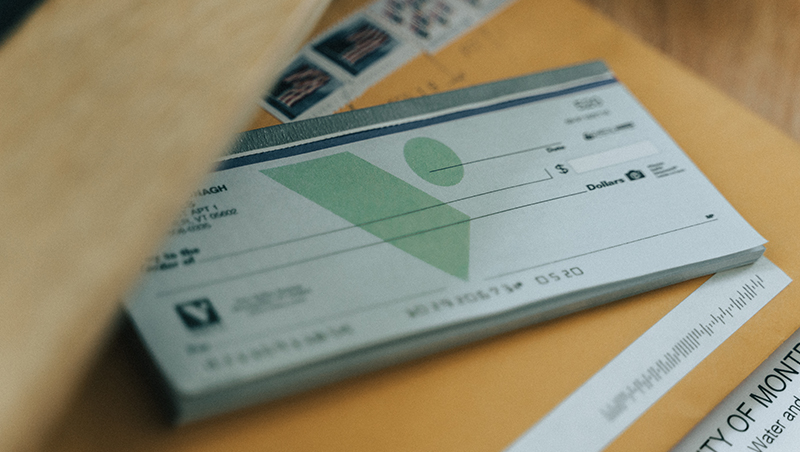How to Balance Your Checkbook

If you’ve ever bounced a check, you know that it’s an expensive mistake to make. Not only does your financial institution charge you a fee, you may also have to pay a fee to the person or company you bounced the check with. A bounced check could cost $30 or more, depending on your situation. And if your checking account is already low on funds, that can feel like a blow to the gut.
The best way to prevent bounced checks is to track your finances in a check register. Then, you can keep the register balanced so you know what you have at all times. In our increasingly electronic world, many people count on online banking or their mobile banking app to track expenses, but the balance shown in your account only reflects debit card payments and checks that have been cashed. If someone holds onto a check you’ve written, it won’t appear in your account, making it appear that you have more money than you do. And that’s where trouble comes in.
WHY SHOULD YOU BALANCE YOUR CHECKBOOK?
There are many great reasons to balance your checkbook regularly, aside from preventing overdrafts. It will help you…
- Keep tabs on how you’re spending your money,
- Identify errors your financial institution has made, and
- Discover fraud more quickly.

Protect Your Identity with Edge Pay
Monitor your credit and secure your finances with our modern debit card.
HOW DO YOU GET STARTED?
Getting started is simple. If you use checks, you should have received a check register with the checks. The register is easy to carry with you so you can write down your expenses and subtract them for an updated balance in real time.
There are apps as well, of course, but we’re going to teach you the old school method—it’s the best way to learn the process and allows you to pay close attention to how cash is coming into your account and why it is leaving. Once you’ve learned the process and worked in the register for a while, you can decide whether a budgeting app or another tool is right for you.
WHAT ARE THE STEPS FOR RECORDING TRANSACTIONS?
You will record all of the income you deposit into your checking account and all of the expenses that come out of your checking account. In other words, you will not write in cash payments you make or payments you make with your credit card. Just payments that affect your account. So, here’s what you do:
Step One: Write your starting balance in the balance column. There should be a space at the upper right corner of the register for your balance brought forward. (The “balance brought forward” is the balance you are beginning with or the balance brought forward from another register.)
Step Two: Record the details of each transaction, whether it’s a deposit, a check, or a debit card swipe. You’ll need to write in the following information, if you have it:
- Check number or transaction code
- Date
- A brief description of the transaction
- The amount—you’ll place payments/fees/withdrawals in one column and deposits/credits in a different column so they’re easy to identify.
Step Three: After each transaction, add your deposit/credit or subtract your payment/fee/withdrawal from the previous balance. This will give you your new balance.
HOW DO I BALANCE MY CHECKBOOK USING MY STATEMENT?
To balance your checkbook, you need your check register, your bank statement, a pen/pencil, and a calculator. Pull those things together and take a seat.
Step One: To get started, you’re going to want to make sure the numbers you recorded in your register match those on your statement. To do this, go down through each entry, whether it’s a credit or a withdrawal, matching the entry on your statement to the identical entry in your register. You’ll want to make a checkmark next to the number on your statement as well as the matching number in your register. You’ll notice that your register has a handy column just for that checkmark.
This first step will help you identify any inconsistencies between the amounts you recorded and the amounts your financial institution recorded. If there is a discrepancy—say you find an entry for a charge you don’t remember making or you notice that the amount is significantly different—take time to investigate what happened. Oftentimes, I find that I simply forgot to write it down or I swapped numbers when writing it down. Sometimes, however, the charge is either a mistake or an instance of fraud. In these cases, you need to take action by immediately calling your financial institution or the person or organization responsible for the error.
Step Two: Once you’ve matched up all of your entries, you need to figure out what your balance is. To do this, you will have to do a little math. Here are the steps:
- Note the balance next to the last entry you checked off. This is your balance if all checks and deposits listed above it have been made.
- There will likely be entries above the balance that were not checked off when you went through your statement. Those entries are not calculated into the balance on your statement, so you have to eliminate them from the balance in your checkbook in order to make the two balances match. Take note of these unchecked entries and so some simple math:
- Subtract any unchecked deposits/credits from the balance.
- Add any unchecked checks/fees/withdrawals to the balance.
The resulting number is your balance and should match the balance provided on your statement. If it does not, check your math. Some people draw a line after this number to note where they left off, but the checkmarks can also lead you to the spot–do what works for you.
CAN I USE AN APP NOW?
Budgeting apps can be extremely helpful for those who like to work with technology, and they are certainly a valid choice for keeping your finances in order. I suggest working with a paper register initially and moving to an app when you’ve mastered the concepts.

You Also Might Like

Planning for Spring Break on a Budget: A Guide for Savvy Travelers

Taxes and Homeownership: Consult a Professional

Debt Snowball vs. Debt Avalanche: Two Ways to Get Out of Debt

Stay informed
Stay up to date on financial tips, tricks, and tools that will build your financial literacy and help you live a more prosperous life.
